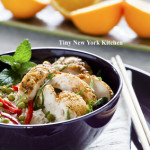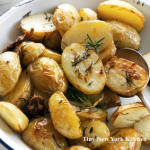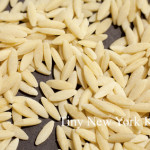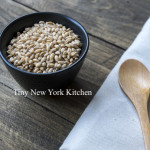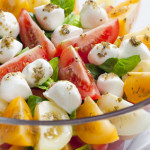English peas (sometimes called garden peas or pod peas) have a fresh, slightly grassy flavor that is the essence of spring. English peas are wonderful puréed and made into a creamy soup or spread. They add bright points of color and flavor to pilafs, risotto, fried rice, pasta, and soups. Steamed and sprinkled with fresh mint or parsley, they make a wonderful side dish.
Pods should be bright green and feel heavy. Each 1 pound of whole pods yields about 1 cup of shelled peas so make sure to pay attention to the desired measurement in your recipe. Their sugars convert quickly to starch so English peas are best eaten the day that they are purchased. If needed, store them in an airtight container in the refrigerator for up to 3 days. To prepare, shell peas right before cooking them in order to keep them from drying out. Once shelled, peas can be briefly cooked in 1/4 inch of steaming water for 3 to 4 minutes. They will quickly turn soggy and lose their vibrant color, so it is important not to overcook them.
“Work With What You Got!”
©Tiny New York Kitchen © 2021 All Rights Reserved
These freezer essentials will help you with your weekly meal prep as well as last minute meals that you need to get on the table fast.
Bagged frozen vegetables, like mixed peppers, broccoli, and spinach.
Bagged frozen fruit, like blueberries, mangos, bananas, and strawberries.
Bagged frozen pastas, like tortellini and ravioli.
Frozen waffles and pancakes.
Frozen potatoes, like tots, fries, and breakfast potatoes.
Rice and prepared side dishes.
Pre-made dough, pie crusts, and breads.
Frozen foods are not limited to frozen dinners. You can stock your freezer with healthier ingredients to make putting dinner together easy. There are endless possibilities with what you can make with frozen ingredients. As always, be creative and “work with what you got!”
“Work With What You Got!”
©Tiny New York Kitchen © 2020 All Rights Reserved
Eating well just got easier. Use one or more ingredients from each of the five categories. Stick with one international flavor profile. Find a sauce in your market’s global-foods section: ssamjang, chutney, hot sauce, salsa, pesto, chimichurri, romesco, aioli, tahini, or peanut sauce. Save money by using leftovers. Save time by using prechopped fresh vegetables.
CHOOSE A BASE INGREDIENT
1/2 Cup
Cooked Brown Rice, Quinoa, Millet, Bulgur, Farro, Barley, Whole Grain Pasta
CHOOSE A LEAN PROTEIN
3 To 4 Ounces
Cooked Meat, Poultry, Seafood, Legumes, Eggs, Tofu
CHOOSE VEGETABLES
1 To 2 Cups
Vary Colors And Textures
CHOOSE A SAUCE
1 To 3 Tablespoons
Sriracha, Harissa, Soy, Sweet Chili, Ssamjang, Chutney, Hot Sauce, Salsa, Pesto, Chimichurri, Romesco, Aioli, Tahini, Peanut Sauce
Bowl Ideas
Korean: Cooked noodles or rice, shredded carrot, sliced cucumber, sliced daikon radish, bean sprouts, sliced grilled beef, runny fried egg, ssamjang, kimchi
Middle Eastern: Cooked bulgur, roasted eggplant, roasted cauliflower, sautéed spinach, cooked chickpeas, grilled chicken, minted yogurt sauce, roasted pumpkin seeds, za’atar spice blend
Italian: Cooked faro, sautéed zucchini, sautéed kale, roasted red peppers, roasted cherry tomatoes, tuna, pesto, olives, marinated artichoke hearts, pine nuts
“Work With What You Got!”
©Tiny New York Kitchen © 2019 All Rights Reserved
I don’t know what’s more comforting than potatoes. A staple food in many parts of the world, potatoes are an integral part of much of the world’s food supply. Potatoes are the world’s fourth-largest food crop after maize, wheat, and rice.
There are currently over 1,000 different types of potatoes.
White Potatoes: These all-purpose potatoes are moderately starchy with a dense, creamy texture and can be roasted, baked, boiled, or steamed.
Russet Potatoes: Starchy and fluffy, these potatoes are ideal for mashing and baking, as well as French fries and latkes.
Fingerling Potatoes: Small, knobby fingerlings have thin, delicate skin that doesn’t need to be peeled. Their firm texture stands up to roasting, boiling, and pan-frying.
Baby Potatoes: Also known as new potatoes, these tiny potatoes come in a rainbow of colors (another reason to leave the skin on). They are best cooked whole and boiled, steamed, or roasted.
Gold Potatoes: These thin-skinned potatoes (also called yellow potatoes) are beloved for their buttery flesh. They’re fluffy enough to be smashed yet firm enough to be used in soup or stew.
Red Potatoes: Ruby skin gives these potatoes visual appeal, and their firm and waxy texture means they soak up flavor without turning too soft. They are ideal for salads and gratins.
Look for potatoes without any bruises, cuts, wrinkles, or soft spots, which can all be signs of age or poor handling. If they smell like soil, that’s typically an indication of freshness. While fresh is best, potatoes keep for quite some time. Store them in a spot that’s cool, dark, and dry. If eyes sprout, simply cut them off and use the potatoes as normal. Potatoes provide vitamins C and B6, plus iron and potassium. While the whole potato contains fiber, you will get an extra boost if you leave the skin on.
“Work With What You Got!”
©Tiny New York Kitchen © 2019 All Rights Reserved
To flavor your food reach for herbs and spices rather than high-sodium table salt. Make sure to read the labels of seasoning mixes because many of them contain salt.
Seasoning Suggestions
Pasta: Basil, Fennel, Garlic, Paprika, Parsley, Sage
Potatoes: Chives, Garlic, Paprika, Parsley, Rosemary
Rice: Cumin, Marjoram, Parsley, Saffron, Tarragon, Thyme, Turmeric
Seafood: Chervil, Dill, Fennel, Tarragon, Parsley
Vegetables: Basil, Caraway, Chives, Dill, Marjoram, Mint, Nutmeg, Oregano, Paprika, Rosemary, Savory, Tarragon, Thyme
“Work With What You Got!”
©Tiny New York Kitchen © 2019 All Rights Reserved
The end of summer is fresh produce heaven, which includes delicious vine ripened tomatoes. What do you do when you have a tomato abundance?
Here are some tips for making the most of the end of summer tomatoes.
Sliced: Incorporate into sandwiches or add to basil and mozzarella for a Caprese Salad.
Chopped: You only need a few chopped heirloom tomatoes, mozzarella, chopped basil, and olive oil for a colorful no-cook pasta sauce.
Puréed: There’s nothing like an icy cold gazpacho on a warm day.
Salsa: Fresh salsa is a must have condiment for grilled steaks or shrimp, brown rice and beans, scrambled eggs, and of course, chips.
Grilled: Toss cherry tomatoes with olive oil, garlic, and herbs. Then cook in a grill basket until charred. Top fish, chicken, pasta, and charred slices of bread.
Stored: Keep tomatoes at room temperature until ripe and then use within a day or two. Don’t put them in the refrigerator as it affects their flavor and texture.
Preserved: Roasted, dehydrated, or stewed – savor the season by saving a taste of summer for later.
“Work With What You Got!”
© Victoria Hart Glavin Tiny New York Kitchen © 2017 All Rights Reserved
Orzo is the Italian word for barley; however, orzo is not made from barley at all, but rather from semolina, which is a course ground flour made from durum wheat. With its shape reminiscent of slivered almonds, orzo cooks up in about half the time of rice, making it a speedy standby to have on hand to add heartiness to meals.
Just bring 3 quarts of lightly salted water to a boil. Add 8 ounces ( 1 1/2 cups) dried orzo and boil about 10 minutes until it has a firm, chewy texture. Stir occasionally to prevent it from sticking together. Drain orzo in colander and serve immediately.
Rinse orzo only if it will be baked or served cold in a salad. Otherwise, do not rinse as rinsing removes a light coating of starch that helps sauces and seasonings cling to the pasta.
For the best texture and flavor serve orzo immediately after cooking. If your orzo gets done before the rest of the meal, you can keep it warm by returning the cooked drained pasta to the warm cooking pan. Stir in a little butter or olive oil to prevent it from sticking together. Cover the pasta with a lid and let it stand no more than 14 minutes.
“Work With What You Got!”
© Victoria Hart Glavin Tiny New York Kitchen © 2017 All Rights Reserved




